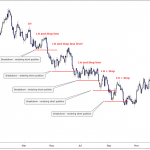- Learn the basics of Forex trading in this first aricle in our FX Trading Course: Who are the players? Reasons to why people trade, FX's advantages and more.
“What is Forex Trading?” is a basic question which is asked by a trader looking forward to entering this market, and in this article you will learn all you need to know about Forex trading. Who are the players? Reasons to why people trade FX? Forex advantages, how currencies are quoted, and about the major Foreign Exchange pairs.
Now, lets go back to the first question: What is Forex Trading? The chances are high that you had already taken part in this market when you exchanged your domestic currency with another national currency. For instance, if you’ve been to Paris, you are required to exchange your currency to Euros as France falls within the Eurozone. This is a small example of Forex exchange market.
Forex often shortened as FX is short for Foreign Exchange. It is one of the largest financial markets in the world, with conservative estimates from BIS Triennial Survey calculating its daily turnover to be close to 5 trillion dollars. That means that the total volume traded every day for one week in foreign exchange markets equals the total annual US GDP.
Entities trading forex include companies which sell their products overseas using different currencies, along with various governments and central banks which participate in the daily market. Apart from that, various large institutions as well as smaller traders have started speculating on the value of currencies from around the world.
What Are the Prime Reasons for Forex Trading?
Forex traders aim to extract profits from changing currency prices, following a similar principle to that of the stock and bond market. A forex trader tends to buy a currency if they predict that its price will go up. Similarly, they tend to sell a currency if they feel that the price will go down in the future. In Forex trading, currencies are quoted in pairs, while the price of the currency is called an “exchange rate.”
Let us take the EUR/USD trading pair trading at 1:20 as an example. This indicates that one Euro can buy 1.20 US dollars or US 1.20 Dollars can buy 1 EUR. In this case, a forex trader will tend to buy the pair, if he/she thinks that the exchange rate will go up and sell if they think that the exchange rate will drop. A profit or loss is thus generated when the trader takes a trading decision, which also depends on how the trader analyses the market.
Types of Forex Traders
The retail Forex trading industry started to gain traction due to technological advancements around the start of the new millennia and currently accounts for 5% of the global FX market. Retail traders refer to individual traders, who have relatively small trading accounts. They can access the forex market through a combination of online brokerages, trading software, and today now, even APIs.
There are many ways of Trading Forex. Scalpers, day traders, swing traders, and position traders are the main types of speculators that normally take part in the market. Among these, there is a lack of position traders among retail traders, as it requires a substantial amount of capital to hold positions for months and even years. The rest of the trading styles are explained in brief below.
- Forex Scalpers: Scalpers are mainly concerned with collecting small gains on their trades, usually holding them for a very short period, and often for just a few seconds. Thus, they tend to open over dozens of trades during a particular day. It is regarded as a fast-paced trading style which is not suitable for everyone, which can be the reason behind most retail traders being day traders rather than scalpers.
- Forex Day Traders, on the other hand, usually open their positions early in the morning and leave them open to perform during the day, which is also the reason why they are so named. They tend to utilize several types of analysis for deciding whether to purchase or sell a particular currency. They can be further subdivided into three types, namely, breakout traders, trend traders, and counter-trend traders. Day traders tend to open significantly fewer trades as compared with their Scalping counterparts.
- Forex Swing Traders: Swing Trading is another popular trading style, possessing a slightly longer time horizon than a day. They tend to anticipate and trade on price swings, which require them to open their trades for days and even weeks. Since they are not required to monitor the screen all day long, most swing traders have regular day jobs.
Advantages of Forex Trading over Other Markets
Compared to other financial markets, the forex trading has several obvious benefits that are listed below.
- Open for 24hrs per day: The Forex trading is an over-the-counter market, operating round the clock. This is in stark contrast with the stock exchanges, which only operate during specific times of the day. Because currencies are traded in major financial centers from around the world, the Forex market remains open and operational from Sunday through Friday.
- Highest Leverage: When it comes to leverage, the forex market provides the highest leverage among all other markets. However, traders are advised to be careful while trading with leverage as they tend to magnify both profits as well as losses.
- Only eight major currencies: Compare this with the stock markets which houses thousands of stocks, when trading forex speculators will primarily focus on the eight major currencies. It makes it simpler for the trader to follow important market news for just a few currencies rather than on hundreds of companies when they search for trading opportunities. Even if we include some exotic currencies, the total still falls short of the number of stocks in the stock market.
Another advantage of Forex trading is the potential to make money on price gains and losses. Comparatively, the ability to short sell stocks is usually restricted in the stock market. After going through the basics of the Forex market, we shall now cover currencies in more detail, starting with currencies and their quotation standards.
How are currencies quoted?
Currencies are required to be quoted in pairs, with a single currency pair consisting of two currencies, namely, the base currency and the counter currency.
If we take the USD/JPY trading pair, as an example, the pair indicates that one US dollar can purchase 110 Japanese Yen. It also means that 110 Japanese Yen can buy one US dollar.
It should be noted that commonwealth currencies or “Her Majesty’s currencies” are almost always quoted as the base currency, as evident in AUD/USD, GBP/USD and CAD/JPY, etc.
Bid/Ask prices and Spreads
There are two prices in each currency, one at which the market buys the currency known as the Bid price and one at which the market sells the currency to you, which is known as the Ask price. The “spread” is calculated as the difference between the bid and ask prices. This is generally the broker’s profit for the service of executing your trade and finding a potential buyer or seller.
What are Majors and Cross Pairs?
As mentioned below, there are eight major currency pairs that are traded in the Forex market. These include the Australian Dollar (AUD), British Pound (GBP), US Dollar (USD), Swiss Franc (CHF), Canadian Dollar (CAD), New Zealand Dollar (NZD), Japanese Yen (JPY) and of course, the Euro (EUR). The list if further expanded, will include all G10 currencies, such as Norwegian Krone and the Swedish Krona. Almost all of the so-called major currency pairs are also considered the most liquid pairs in the market, as the US Dollar is included in more than 80% of the world’s foreign exchange transactions. Major pairs such as EUR/USD and GBP/USD always include the US Dollar as either the base currency or the counter currency.
Cross Pairs, on the other hand, refer to major currency pairs that do not include the US Dollar. Examples include EUR/CHF, GBP/JPY, and AUD/CAD.
Thus, from our observations, we can see that major currencies are used in the most developed countries in the world as they account for the greatest volume of capital flows and global trade. They are thus the most traded currencies in the world, as such currencies need to be bought and sold on the Forex market to perform transactions.
It should be noted that some of the major currency pairs are used as reserve currencies by central banks across the world. Currencies belonging to commodity-exporting countries such as Canada and Australia also have a high correlation with the price of the commodities they export. Some currencies such as the Japanese Yen and the Swiss Franc are considered as safe havens during times of economic or political turmoil as they are used funding currencies in good times.



